
- Home
- Travel Packages
- Top Destination
-
Travel Attraction
By Category
Top Attraction

- Travel Agents
- Car Rentals
- Hotels
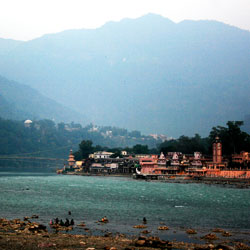
About The Triveni Ghat Temple The Triveni Ghat Temple, situated in the holy town of Rishikesh, is one of the most revered temples in India. It is located on the banks of the sacred Ganges River and is considered to be a place of great spiritual significance. The temple attracts thousands of pilgrims and tourists from all over the world who come to seek blessings and immerse themselves in the spiritual aura of the place. Architecture of Triveni Ghat Temple The Triveni Ghat Temple is a beautiful example of traditional Indian temple architecture. The temple is built in a classical North Indian style, with intricate carvings and designs adorning its walls and pillars. The main sanctum of the temple houses a magnificent idol of Lord Shiva, the presiding deity of the temple. The temple complex also includes smaller shrines dedicated to various other Hindu deities. The temple is surrounded by a serene and peaceful atmosphere, with the sound of the flowing Ganges adding to its spiritual charm. The ghats of the temple are a popular spot for devotees to take a holy dip in the sacred river and perform rituals and prayers. History The Triveni Ghat Temple has a long and rich history that dates back several centuries. According to ancient texts and legends, the temple was established at the confluence of the Ganges, Yamuna, and Saraswati rivers, which is considered to be a highly auspicious location in Hindu mythology. It is believed that by taking a dip in the holy waters of the Triveni Ghat, one can cleanse their sins and attain spiritual enlightenment. Over the years, the temple has been renovated and expanded several times to accommodate the growing number of devotees who come to seek blessings and offer prayers. Today, the Triveni Ghat Temple stands as a symbol of faith and devotion for millions of people who visit it every year. Best Time To Visit The best time to visit the Triveni Ghat Temple is during the winter months, from October to March, when the weather is pleasant and cool. This is also the time when several festivals and events are celebrated at the temple, making it a vibrant and lively place to visit. Another good time to visit the temple is during the monsoon season, from July to September, when the river is in full flow and the surrounding hills are lush and green. However, it is advisable to check the weather conditions before planning a trip during this time as heavy rains can sometimes lead to flooding in the area. How To Reach The Triveni Ghat Temple is located in the heart of Rishikesh, which is well-connected to major cities in India by road, rail, and air. The nearest airport is the Jolly Grant Airport in Dehradun, which is about 21 kilometers away from Rishikesh. From the airport, you can hire a taxi or take a bus to reach the temple. If you are traveling by train, the nearest railway station is in Haridwar, which is about 25 kilometers away from Rishikesh. From Haridwar, you can take a taxi or a bus to reach the temple. Rishikesh is also well-connected by road, with regular bus services from Delhi, Dehradun, and other major cities in North India. Significance Of The Triveni Ghat Temple The Triveni Ghat Temple holds great significance for devotees and pilgrims who come to seek blessings and perform rituals. It is believed that taking a dip in the sacred waters of the Ganges at the Triveni Ghat can cleanse one's sins and purify the soul. Many people also come to the temple to offer prayers and seek the blessings of Lord Shiva, who is considered to be the destroyer of evil and the god of transformation. Visiting the Triveni Ghat Temple is not just a religious experience but also a spiritual one, as the serene and tranquil atmosphere of the temple helps one to connect with their inner self and find peace and solace. The temple is also a popular spot for meditation and yoga, with many spiritual seekers coming here to practice mindfulness and self-reflection. In conclusion, the Triveni Ghat Temple in Rishikesh is a sacred place that attracts devotees and tourists from all walks of life. Its rich history, beautiful architecture, and spiritual significance make it a must-visit destination for anyone seeking a deeper connection with their faith and inner self.
Explore More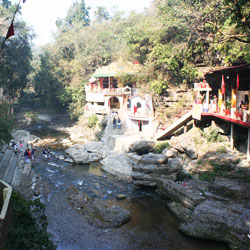
About The Tapkeshwar Temple The Tapkeshwar Temple is a renowned Hindu temple located in Dehradun, Uttarakhand. It is dedicated to Lord Shiva and is believed to be one of the oldest temples in the region. The temple is situated on the banks of the Asan River and is surrounded by lush greenery, making it a peaceful and serene place for devotees to visit. Architecture of Tapkeshwar Temple The architecture of the Tapkeshwar Temple is a perfect blend of traditional and modern styles. The temple features intricate carvings and sculptures that depict various Hindu mythological stories. The main sanctum sanctorum houses the Shivlinga, which is worshipped by devotees. The temple also has a large courtyard where devotees can offer prayers and perform rituals. History The history of the Tapkeshwar Temple dates back to ancient times. It is believed that the temple was built by Guru Dronacharya, the legendary teacher of the Kauravas and Pandavas from the epic Mahabharata. According to legend, Lord Shiva himself appeared at this place to meditate, which is why the temple holds great significance for devotees. Best Time To Visit The best time to visit the Tapkeshwar Temple is during the months of February to June and September to November when the weather is pleasant and suitable for sightseeing. The temple also sees a large number of devotees during the festival of Maha Shivratri, which is celebrated with great pomp and show. How To Reach The Tapkeshwar Temple is easily accessible from Dehradun city. It is located about 6 kilometers from the city center and can be reached by road. Visitors can hire a taxi or take a bus to reach the temple. The nearest railway station is in Dehradun, and the nearest airport is the Jolly Grant Airport in Dehradun. Significance Of The Tapkeshwar Temple The Tapkeshwar Temple holds great significance for devotees of Lord Shiva. It is believed that worshipping at this temple can fulfill wishes and bring prosperity to the devotees. The natural surroundings of the temple add to its peaceful and spiritual ambiance, making it a popular destination for pilgrims and tourists alike. In conclusion, the Tapkeshwar Temple in Dehradun is a sacred place of worship that attracts devotees from near and far. With its rich history, beautiful architecture, and serene surroundings, the temple offers a unique spiritual experience for visitors. Whether you are a religious pilgrim or a curious traveler, a visit to the Tapkeshwar Temple is sure to leave you feeling refreshed and spiritually uplifted.
Explore More
About The Kunjapuri Temple The Kunjapuri Temple is a revered Hindu temple located in the holy town of Rishikesh in the state of Uttarakhand, India. Situated at an altitude of 1,676 meters above sea level, the temple offers breathtaking panoramic views of the surrounding Himalayan mountains and the Ganges River below. It is dedicated to Goddess Durga, one of the most revered deities in Hinduism. Architecture of Kunjapuri Temple The architecture of Kunjapuri Temple is simple yet elegant. The main shrine is built in traditional North Indian style, with a pyramid-shaped roof and intricate carvings on the walls. The temple is adorned with colorful flags, bells, and religious symbols that add to its spiritual ambiance. The highlight of the temple is the idol of Goddess Durga in a sitting posture, adorned with flowers and ornaments. The temple complex also includes smaller shrines dedicated to other Hindu deities. History The Kunjapuri Temple has a rich historical significance in Hindu mythology. It is believed to be the place where the chest of Sati, the wife of Lord Shiva, fell after her body was dismembered by his cosmic dance of destruction, the Tandav. The temple is considered a powerful spiritual center where devotees come to seek blessings, peace, and fulfillment of their wishes. The temple has been a place of worship and pilgrimage for centuries, attracting devotees from far and wide. Best Time To Visit The best time to visit Kunjapuri Temple is during the early morning hours to witness the mesmerizing sunrise over the Himalayan peaks. The temple also offers stunning views of the sunset and the twinkling lights of Rishikesh town at night. The temple is open throughout the year, but the months of October to March are considered ideal for visiting due to pleasant weather conditions and clear skies. It is advisable to avoid the monsoon season from July to September when the region experiences heavy rainfall and landslides. How To Reach Kunjapuri Temple is located approximately 25 kilometers from Rishikesh and can be easily reached by road. Visitors can hire a taxi or take a local bus from Rishikesh to reach the temple. The nearest airport is Jolly Grant Airport in Dehradun, which is about 35 kilometers away. From the airport, one can hire a taxi or take a bus to reach the temple. The temple is also accessible by a short trek of about 300 steps from the base point, which offers a scenic journey through lush green forests and pristine surroundings. Significance Of The Kunjapuri Temple The Kunjapuri Temple holds immense significance for devotees and spiritual seekers. It is believed to be a place of divine energy and spirituality, where one can connect with the cosmic forces of the universe. The temple is a popular destination for those seeking spiritual awakening, inner peace, and healing. Many visitors come to the temple to offer prayers, perform rituals, and seek blessings for their well-being and prosperity. The serene and tranquil atmosphere of the temple makes it a perfect place for meditation, reflection, and self-discovery. In conclusion, the Kunjapuri Temple in Rishikesh is a sacred place that embodies the beauty, spirituality, and mystique of the Himalayas. It is a place where devotees can immerse themselves in the divine presence of Goddess Durga and experience a sense of peace and harmony. The temple's stunning location, rich history, and architectural grandeur make it a must-visit destination for anyone seeking spiritual enlightenment and a deeper connection with the divine.
Explore More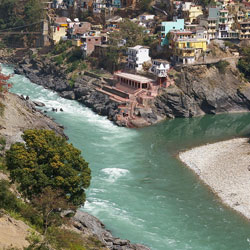
About The Devprayag Temple The Devprayag Temple is a famous Hindu shrine located in the town of Devprayag in Uttarakhand, India. It is dedicated to Lord Rama and is considered to be one of the holiest temples in the region. The temple is situated at the confluence of the Alaknanda and Bhagirathi rivers, which merge to form the sacred Ganges River. Architecture of Devprayag Temple The Devprayag Temple is built in the traditional North Indian architectural style, with intricate carvings and sculptures adorning its walls and pillars. The temple has a towering spire, known as a shikhara, which is a characteristic feature of Hindu temples. The sanctum sanctorum of the temple houses a beautiful idol of Lord Rama, along with other deities. History The history of the Devprayag Temple dates back to ancient times, with references to the temple found in various Hindu scriptures and texts. It is believed that the temple was built by Adi Shankaracharya, a renowned Hindu philosopher and saint, who established the temple as a place of worship for devotees. Over the years, the temple has undergone several renovations and restorations, but its spiritual significance has remained unchanged. Best Time To Visit The best time to visit the Devprayag Temple is during the winter months, from October to March, when the weather is cool and pleasant. This time of year is ideal for exploring the temple and its surroundings, as the clear skies offer stunning views of the rivers and mountains. The temple also attracts a large number of devotees during festivals and special occasions, so visiting during these times can provide a unique cultural experience. How To Reach Devprayag is well-connected by road, making it easily accessible from major cities in Uttarakhand. The nearest airport is in Dehradun, which is around 70 kilometers away from Devprayag. From the airport, one can hire a taxi or take a bus to reach the town. The nearest railway station is in Rishikesh, which is approximately 75 kilometers from Devprayag. Buses and taxis are available from Rishikesh to reach the temple. Significance Of The Devprayag Temple The Devprayag Temple holds immense religious and spiritual significance for Hindus, as it is believed to be the place where Lord Rama performed penance to atone for his sins. The confluence of the rivers at Devprayag is considered to be a sacred site, known for its purifying properties. Devotees visit the temple to seek blessings, offer prayers, and participate in various rituals and ceremonies. The tranquil and serene atmosphere of the temple complex makes it an ideal place for meditation and spiritual reflection. In conclusion, the Devprayag Temple is a sacred pilgrimage site that attracts devotees and tourists from all over the country. With its rich history, stunning architecture, and spiritual significance, the temple stands as a testament to the enduring faith and devotion of the Hindu community. Visiting the Devprayag Temple offers a unique opportunity to experience the cultural and religious heritage of Uttarakhand, while also providing a peaceful retreat for those seeking spiritual solace.
Explore More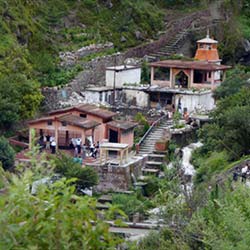
About The Tapovan Temple The Tapovan Temple is a revered Hindu temple located in Dehradun, Uttarakhand. Situated amidst the serene and picturesque surroundings of the Tapovan Forest, this temple holds great spiritual significance for devotees and visitors alike. The tranquil atmosphere and the sacred vibes of the temple make it a popular destination for those seeking peace and spiritual rejuvenation. Architecture of Tapovan Temple The Tapovan Temple boasts of a unique and exquisite architectural style that reflects the ancient Hindu design principles. The main shrine of the temple is dedicated to Lord Shiva, adorned with intricate carvings and sculptures. The temple complex also houses smaller shrines dedicated to other Hindu deities, adding to the spiritual aura of the place. History The history of the Tapovan Temple dates back to ancient times, with legends and myths surrounding its origin. It is believed that sages and saints used to meditate in the serene forests of Tapovan, making it a sacred place for spiritual practices. The temple was later built to commemorate the divine presence of these holy beings and has since been a place of worship and pilgrimage for devotees. Best Time To Visit The best time to visit the Tapovan Temple is during the months of October to March, when the weather is pleasant and conducive for exploring the natural beauty of the surroundings. The winter months offer a serene and peaceful ambiance, ideal for meditation and spiritual contemplation. However, visitors can also visit the temple during other times of the year to experience the unique charm and tranquility of the place. How To Reach The Tapovan Temple is easily accessible from Dehradun city, located at a distance of about 5 kilometers. Visitors can hire a taxi or take a local bus to reach the temple premises. The nearest airport is the Jolly Grant Airport in Dehradun, which is well-connected to major cities in India. For those traveling by train, the Dehradun Railway Station is the closest railhead to the temple. Significance Of The Tapovan Temple The Tapovan Temple holds great significance for Hindus as it is believed to be a place of meditation and spiritual awakening. The serene surroundings of the temple provide a peaceful retreat for devotees seeking solace and inner peace. The temple complex also hosts various religious ceremonies and festivals, attracting a large number of pilgrims and tourists throughout the year. In conclusion, the Tapovan Temple in Dehradun is a sacred place that exudes tranquility and spirituality. The unique architecture, serene atmosphere, and historical significance make it a must-visit destination for those seeking a deeper connection with the divine. Whether you are a devout worshipper or a curious traveler, a visit to the Tapovan Temple is sure to leave you with a sense of peace and enlightenment.
Explore More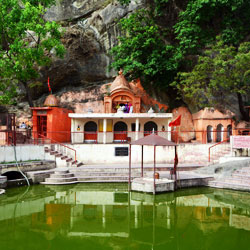
About The Bhimgoda Kund Temple The Bhimgoda Kund Temple, located in Haridwar, is a famous Hindu pilgrimage site that holds great significance for devotees. The temple is dedicated to Lord Shiva and is nestled on the banks of the holy river Ganga. The temple is believed to have been built at the spot where Bhima, one of the Pandava brothers from the epic Mahabharata, is said to have created a kund (pond) by striking the ground with his knee. This kund is now known as Bhimgoda Kund, and it is considered sacred by devotees who visit the temple for a holy dip. Architecture of Bhimgoda Kund Temple The Bhimgoda Kund Temple boasts a unique architectural style that reflects the rich cultural heritage of India. The temple features intricate carvings and sculptures that depict various Hindu deities and mythological figures. The temple premises also include a large water tank, believed to be the original kund created by Bhima. Pilgrims can be seen taking a dip in the kund to cleanse themselves of their sins and seek blessings from the gods. History The history of the Bhimgoda Kund Temple dates back to the time of the Mahabharata. According to legend, during their exile, the Pandava brothers visited Haridwar and sought the blessings of Lord Shiva. It was during this time that Bhima, in a fit of rage, struck the ground with his knee, creating the sacred kund. The temple was later constructed at this spot to commemorate the event and honor Lord Shiva. Best Time To Visit The best time to visit the Bhimgoda Kund Temple is during the months of October to March when the weather is pleasant and conducive for sightseeing and pilgrimage. The temple also sees a large influx of devotees during the festivals of Maha Shivaratri and Kartik Purnima when special prayers and rituals are conducted at the temple. How To Reach The Bhimgoda Kund Temple is easily accessible from various parts of Haridwar. It is located near the Har Ki Pauri Ghat, one of the most popular ghats in the city. Visitors can reach the temple by hiring a taxi or auto-rickshaw from any part of Haridwar. The nearest railway station is Haridwar Junction, which is well-connected to major cities in India. The nearest airport is Jolly Grant Airport in Dehradun, which is approximately 35 kilometers away from Haridwar. Significance Of The Bhimgoda Kund Temple The Bhimgoda Kund Temple holds immense significance for devotees who believe that taking a dip in the sacred kund can wash away their sins and bring them closer to the gods. The temple is also a popular pilgrimage site during the Kumbh Mela, a grand religious gathering that takes place once every twelve years in Haridwar. Devotees flock to the temple during this time to seek blessings and perform religious rituals. Overall, the Bhimgoda Kund Temple is a revered place of worship that attracts devotees and tourists alike with its rich history, unique architecture, and spiritual ambiance. A visit to this temple is sure to leave a lasting impression on the hearts and minds of all who come here seeking solace and divine blessings.
Explore More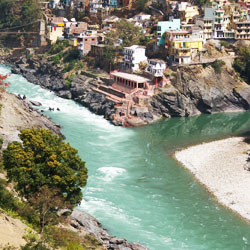
About The Deoprayag Temple The Deoprayag Temple, located in the holy town of Haridwar, holds great significance for Hindus as it is the place where the sacred rivers Alaknanda and Bhagirathi merge to form the mighty river Ganges. This confluence is believed to be a meeting point of the divine energies of Lord Vishnu and Lord Shiva, making it a spiritually important location for devotees. Architecture of Deoprayag Temple The Deoprayag Temple is a beautiful structure that showcases traditional Hindu architecture. The temple is dedicated to Lord Shiva, the presiding deity of the region, and features intricate carvings and sculptures depicting various mythological tales. The temple complex also includes smaller shrines dedicated to other deities, providing a serene and peaceful atmosphere for prayer and meditation. History The history of the Deoprayag Temple dates back to ancient times, with references to the confluence of the rivers Alaknanda and Bhagirathi found in Hindu scriptures and mythology. It is believed that the temple was built to honor the divine union of the two rivers and their significance in Hindu mythology. Over the years, the temple has undergone renovations and expansions, but its spiritual importance has remained unchanged. Best Time To Visit The best time to visit the Deoprayag Temple is during the winter months from October to March when the weather is pleasant and conducive for sightseeing and exploring the surrounding areas. The temple also sees a significant influx of devotees during the holy festivals of Maha Shivaratri and Makar Sankranti, making it a vibrant and lively place for spiritual seekers. How To Reach The Deoprayag Temple is located in the town of Haridwar in the state of Uttarakhand, India. The nearest airport is Jolly Grant Airport in Dehradun, which is approximately 70 kilometers away from the temple. Visitors can also reach Haridwar by rail or road, as the town is well-connected by trains and buses from major cities in India. From Haridwar, the temple is easily accessible by road, and taxis or buses can be availed to reach the sacred confluence. Significance Of The Deoprayag Temple The Deoprayag Temple holds immense significance for Hindu devotees, as it is believed to be a place where the divine energies of Lord Vishnu and Lord Shiva converge. The confluence of the rivers Alaknanda and Bhagirathi is considered to be a sacred site for performing rituals and seeking blessings. Many pilgrims visit the temple to take a holy dip in the confluence and purify themselves spiritually. The Deoprayag Temple is a symbol of unity and harmony, bringing together different facets of Hindu mythology and spirituality in one divine location. In conclusion, the Deoprayag Temple in Haridwar is a place of great religious and spiritual significance, attracting devotees and tourists from all over the world. With its beautiful architecture, rich history, and serene atmosphere, the temple offers a unique experience for those seeking to connect with the divine energy of the sacred rivers and the presiding deities. Visiting the Deoprayag Temple is not just a journey for the body but also for the soul, providing a sense of peace and tranquility amidst the hustle and bustle of everyday life.
Explore More
About The Naina Devi Temple The Naina Devi Temple is a famous Hindu temple located in Nainital, Uttarakhand. It is dedicated to Goddess Naina Devi, who is believed to be the presiding deity of the town. The temple is situated on the northern shore of Naini Lake and is surrounded by lush greenery and beautiful mountains, making it a serene and tranquil location for devotees to visit and seek blessings. Architecture of Naina Devi Temple The Naina Devi Temple is built in the traditional North Indian Nagara style of architecture. The temple has a tall spire and intricate carvings on its walls. The sanctum sanctorum houses the idol of Goddess Naina Devi, adorned with beautiful ornaments and garments. The temple complex also has smaller shrines dedicated to other Hindu deities, adding to its spiritual significance. History The history of the Naina Devi Temple dates back to centuries ago. It is believed that the temple was built during the Kushan period and has undergone several renovations and restorations over the years. According to local legends, the temple is said to be the spot where the eyes of Goddess Sati fell when Lord Shiva was carrying her body. This is why the deity worshipped here is known as Naina Devi, which means "Goddess of Eyes". Best Time To Visit The best time to visit the Naina Devi Temple is during the months of September to November and March to May, when the weather is pleasant and conducive for sightseeing. The temple also experiences a rush of devotees during the Navratri festival, which is celebrated with great fervor and devotion. It is advisable to avoid visiting the temple during the monsoon season as the region receives heavy rainfall and the roads may be slippery and difficult to navigate. How To Reach The Naina Devi Temple is easily accessible by road, rail, and air. The nearest airport is located in Pantnagar, around 65 kilometers away from Nainital. The nearest railway station is in Kathgodam, which is well-connected to major cities like Delhi and Lucknow. From Kathgodam, one can hire a taxi or take a bus to reach Nainital. The temple is located at a short distance from the Nainital bus stand, making it convenient for devotees to visit. Significance Of The Naina Devi Temple The Naina Devi Temple holds great significance for the locals and devotees who visit the temple to seek the blessings of Goddess Naina Devi. It is believed that praying at the temple can help in fulfilling one's wishes and desires. The temple also offers a panoramic view of the Naini Lake and the surrounding mountains, making it a picturesque location for spiritual introspection and meditation. The serene ambiance and divine presence of the Goddess make the Naina Devi Temple a must-visit destination for those seeking peace and tranquility.
Explore More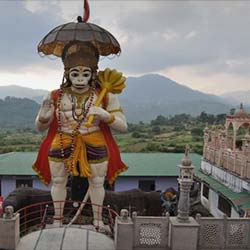
About The Hanuman Garhi Temple The Hanuman Garhi Temple is a famous Hindu temple located in Nainital, Uttarakhand. It is dedicated to Lord Hanuman, the monkey god known for his strength, courage, and devotion. The temple is situated at an altitude of 6,401 feet above sea level and offers panoramic views of the surrounding mountains and the town of Nainital. Architecture of Hanuman Garhi Temple The temple is built in a traditional North Indian architectural style with intricate carvings and bright colors. It has a central sanctum sanctorum where the idol of Lord Hanuman is enshrined. The temple complex also includes other shrines dedicated to Lord Rama and Goddess Durga. The outer walls of the temple are adorned with beautiful sculptures depicting scenes from Hindu mythology. History The Hanuman Garhi Temple was established by Neem Karoli Baba, a revered saint, and devotee of Lord Hanuman. It is believed that he meditated at this spot and had a vision of Lord Hanuman. The temple has since become a popular pilgrimage site for devotees seeking the blessings of the monkey god. Best Time To Visit The best time to visit the Hanuman Garhi Temple is during the months of March to June and September to November when the weather is pleasant and the views are clear. It is also advisable to visit the temple during the early morning or late afternoon to avoid the crowds and to witness the sunrise or sunset from the temple premises. How To Reach The Hanuman Garhi Temple is located around 3 kilometers from the main town of Nainital. Visitors can reach the temple by taking a taxi or a shared auto-rickshaw from Nainital. It is also possible to hike up to the temple through a scenic trail that offers breathtaking views of the surrounding hills and forests. Significance Of The Hanuman Garhi Temple The Hanuman Garhi Temple is considered to be a powerful and sacred site for devotees of Lord Hanuman. It is believed that visiting the temple and offering prayers to Lord Hanuman can bring protection, strength, and success in one's life. The temple also holds a special significance for couples seeking blessings for a happy and prosperous marriage. Overall, the Hanuman Garhi Temple in Nainital is a spiritual haven offering serenity, beauty, and divine blessings to all who visit. Whether you are a devout follower of Lord Hanuman or simply seeking a peaceful retreat in the mountains, a visit to this temple is sure to leave you feeling rejuvenated and uplifted.
Explore More
Introduction Kainchi Dham is a famous temple and ashram located in the Kumaon region of Uttarakhand, India. This spiritual center was established by the revered saint Neem Karoli Baba and has gained international recognition, attracting thousands of devotees and spiritual seekers from around the world. History of Kainchi Dham Kainchi Dham was founded in 1962 by Neem Karoli Baba, a mystic and saint known for his devotion to Lord Hanuman. The name "Kainchi" (meaning scissors in Hindi) is derived from the unique geographical location where two hills intersect in a scissor-like shape. The temple complex was built to honor Lord Hanuman, who is believed to bless devotees with strength and wisdom. Neem Karoli Baba’s teachings emphasized love, service, and devotion to God. His ashram became a center for spiritual awakening, attracting followers from different parts of the world, including famous personalities. Steve Jobs Visit to Kainchi Dham One of the most notable visitors to Kainchi Dham was Apple co-founder Steve Jobs. In the 1970s, Steve Jobs traveled to India in search of spiritual enlightenment. He visited Kainchi Dham and spent time meditating, seeking clarity and purpose. Although he did not meet Neem Karoli Baba, who had passed away in 1973, the experience had a profound impact on his life. Years later, he encouraged Facebook founder Mark Zuckerberg to visit Kainchi Dham for spiritual guidance. How to Reach Kainchi Dham Kainchi Dham is easily accessible from major cities in North India. Here are the different ways to reach the temple: By Air: The nearest airport is Pantnagar Airport, approximately 76 km from Kainchi Dham. From the airport, taxis and buses are available to reach the ashram. By Train: The nearest railway station is Kathgodam, around 37 km from Kainchi Dham. From Kathgodam, one can hire a taxi or take a bus to reach the temple. By Road: Kainchi Dham is well-connected by road and can be accessed via Nainital and Almora. Buses and taxis are available from major cities like Delhi, Haldwani, and Nainital. Distance from Nainital to Neem Karoli Baba Ashram The distance between Nainital and Kainchi Dham is approximately 18 km. It takes around 30-40 minutes by car to reach the temple from Nainital. Kainchi Dham Temperature & Weather Conditions The temperature at Kainchi Dham varies depending on the season: Summer (March to June): Pleasant weather with temperatures ranging between 15°C and 30°C. Monsoon (July to September): Moderate rainfall; the temple looks beautiful but roads can be slippery. Winter (October to February): Cold weather with temperatures dropping to as low as 2°C; sometimes snowfall occurs in nearby areas. Best Time to Visit Kainchi Dham The ideal time to visit Kainchi Dham is between March and June and September to November. The temple celebrates its annual fair on June 15, which is a great time to experience the spiritual energy of the place. Places to Visit Near Kainchi Dham If you are visiting Kainchi Dham, you can also explore several beautiful places nearby: 1. Nainital (18 km): A picturesque hill station known for Naini Lake, Naina Devi Temple, and Mall Road. 2. Bhimtal (30 km): Famous for its scenic lake, island aquarium, and adventure activities. 3. Almora (65 km): A cultural hub with old temples, heritage sites, and stunning Himalayan views. 4. Mukteshwar (50 km): A peaceful hill retreat known for Mukteshwar Temple and breathtaking landscapes. 5. Ranikhet (60 km): A charming cantonment town known for its green meadows, temples, and golf course. Kainchi Dham Retreats & Events Kainchi Dham is not just a place for worship but also a center for spiritual retreats and meditation. Visitors can participate in: Daily Aarti and Bhajan Sessions: Devotional singing and prayers are held at the temple. Meditation and Yoga Retreats: Some followers organize spiritual retreats in nearby locations. Volunteering and Seva Activities: Devotees engage in social service and assist in temple activities. Kainchi Dham Sthapna Diwas (Foundation Day) The Sthapna Diwas (Foundation Day) of Kainchi Dham is celebrated on June 15 every year. This day marks the establishment of the ashram and is observed with great devotion: A grand Bhandara (community feast) is organized. Thousands of devotees visit the ashram to seek blessings. The entire temple complex is decorated beautifully. Kainchi Dham is a sacred place that continues to inspire people from all over the world. Whether you seek spiritual enlightenment, peace of mind, or simply a scenic getaway, this temple offers a unique experience. With its rich history, divine atmosphere, and beautiful surroundings, Kainchi Dham is truly a must-visit destination in Uttarakhand.
Explore More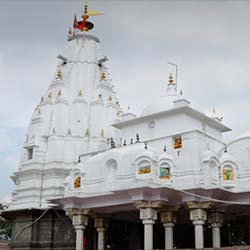
About The Jwala Devi Temple The Jwala Devi Temple is a famous Hindu temple located in Mussoorie, Uttarakhand. It is dedicated to Goddess Jwala, who is believed to be an incarnation of Goddess Durga. The temple is situated atop the Benog Hill at an altitude of 2,240 meters above sea level, offering panoramic views of the surrounding mountains and valleys. Architecture of Jwala Devi Temple The Jwala Devi Temple is built in traditional Garhwali style architecture, with a simple yet elegant design. The temple is made of white marble and features intricate carvings and sculptures of various Hindu deities. The main sanctum sanctorum houses the idol of Goddess Jwala, adorned with flowers and ornaments. The temple complex also includes a small prayer hall where devotees can offer their prayers and seek blessings. History The history of the Jwala Devi Temple dates back several centuries. According to legend, the temple was established by a local king who was a devout follower of Goddess Jwala. It is said that the king had a vision of the goddess instructing him to build a temple in her honor on the Benog Hill. The king then commissioned the construction of the temple, which has since become a popular pilgrimage site for devotees from all over the country. Best Time To Visit The best time to visit the Jwala Devi Temple is during the months of March to June and September to November. During these months, the weather is pleasant and ideal for sightseeing and outdoor activities. The temple also hosts several festivals and events during these months, attracting a large number of devotees and tourists. It is advisable to avoid visiting the temple during the monsoon season as the region experiences heavy rainfall, which can make travel difficult. How To Reach The Jwala Devi Temple is located approximately 9 kilometers from Mussoorie town and can be reached by road. Visitors can hire a taxi or take a local bus from Mussoorie to reach the temple. The nearest railway station is Dehradun, which is around 33 kilometers away. From Dehradun, visitors can hire a taxi or take a bus to reach Mussoorie and then proceed to the temple. The nearest airport is Jolly Grant Airport in Dehradun, which is well-connected to major cities in India. Significance Of The Jwala Devi Temple The Jwala Devi Temple holds great significance for devotees and pilgrims who visit the temple to seek the blessings of Goddess Jwala. It is believed that the goddess fulfills the wishes of her devotees and protects them from evil forces. The temple also offers a peaceful and serene atmosphere, making it an ideal place for meditation and introspection. Many visitors come to the temple to experience spiritual enlightenment and connect with the divine. The Jwala Devi Temple is a must-visit destination for those seeking a spiritual retreat and a unique cultural experience in the beautiful town of Mussoorie.
Explore More
About The Bharatha Temple The Bharatha Temple is a magnificent Hindu temple located in Rishikesh, Uttarakhand. This temple is dedicated to Lord Bharatha, who is believed to be the brother of Lord Rama. The temple is a popular pilgrimage site for devotees seeking blessings and spiritual solace. The serene and tranquil surroundings of the temple make it a peaceful place for meditation and prayer. Architecture of Bharatha Temple The Bharatha Temple exudes exquisite architectural beauty with its intricate carvings, colorful frescoes, and towering spires. The temple follows traditional North Indian architectural styles, with a grand entrance leading to a central courtyard surrounded by smaller shrines dedicated to various deities. The temple's main sanctum sanctorum houses a beautifully adorned idol of Lord Bharatha, attracting devotees from far and wide. History The Bharatha Temple has a rich history dating back several centuries. It is believed that the temple was built by a royal patron in the region to honor Lord Bharatha and seek his blessings. Over the years, the temple has undergone renovations and additions, but its sacred essence has been preserved through generations. The temple stands as a symbol of devotion and reverence towards Lord Bharatha and his teachings. Best Time To Visit The best time to visit the Bharatha Temple is during the Hindu festivals of Ram Navami and Diwali when the temple is adorned with lights, flowers, and decorations. The vibrant atmosphere during these festivals adds to the spiritual experience of visiting the temple. However, the temple is open to visitors throughout the year, allowing devotees to seek solace and blessings whenever they feel the need. How To Reach The Bharatha Temple is conveniently located in the heart of Rishikesh, making it easily accessible by road. Visitors can reach the temple by private vehicles, taxis, or local transportation services. The temple is situated at a short distance from the main market area of Rishikesh, allowing visitors to combine their spiritual journey with a cultural exploration of the town. Significance Of The Bharatha Temple The Bharatha Temple holds immense significance for devotees who believe in the teachings and blessings of Lord Bharatha. The temple is a place of prayer, meditation, and spiritual awakening for those seeking guidance and divine intervention in their lives. The serene ambiance of the temple offers a sense of peace and tranquility, inviting visitors to connect with their inner selves and find solace in the presence of the divine. In conclusion, the Bharatha Temple in Rishikesh is not just a place of worship but a spiritual sanctuary where devotees can seek blessings, find solace, and connect with the divine. The temple's rich history, exquisite architecture, and serene ambiance make it a must-visit destination for those on a spiritual journey in the sacred town of Rishikesh.
Explore MoreNainital - Kausani Tour 4 Night - 5 Days
5 Days/ 4 Night
Nainital - Kausani
Kedarkantha Trek - 4 Nights & 5 Days
5 Days/ 4 Night
Uttarkashi
9N - 10D Char Dham Yatra Package
10 Days/ 9 Night
Kedarnath - Badrinath - Yamunotri - Joshimath - Uttarkashi - Barkot - Guptakashi
Nainital - Jim Corbett And Kausani 4 Night - 5 Days Package
5 Days/ 4 Night
Nainital - Kausani - Corbett
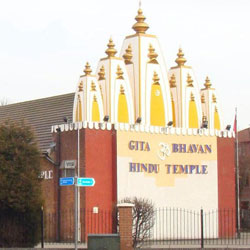
About The Gita Bhavan Temple The Gita Bhavan Temple is a prominent spiritual attraction located in the holy city of Rishikesh, India. It is a revered place of worship for Hindus and followers of the teachings of the Bhagavad Gita. The temple is dedicated to Lord Krishna, who imparted the sacred teachings of the Gita to Arjuna on the battlefield of Kurukshetra. Architecture of Gita Bhavan Temple The Gita Bhavan Temple showcases traditional Indian temple architecture with intricate carvings and beautiful embellishments. The temple complex is adorned with colorful frescoes depicting scenes from the Mahabharata, the epic in which the Bhagavad Gita is a part. The main sanctum of the temple houses a majestic idol of Lord Krishna, attracting devotees from all over the country. History The Gita Bhavan Temple was established as a center for studying and disseminating the teachings of the Bhagavad Gita. It was founded by a group of spiritual leaders and devotees who were inspired by the message of the Gita. The temple has since become a hub for spiritual seekers and pilgrims seeking solace and guidance in the revered scripture. Best Time To Visit The best time to visit the Gita Bhavan Temple is during the winter months of October to March when the weather is pleasant and conducive for spiritual activities. The temple hosts various events and discourses during this time, offering visitors an opportunity to immerse themselves in the teachings of the Bhagavad Gita. How To Reach The Gita Bhavan Temple is conveniently located in the heart of Rishikesh, making it easily accessible by road. Visitors can reach Rishikesh by bus or taxi from major cities like Delhi and Dehradun. The nearest railway station is in Haridwar, which is well-connected to Rishikesh by road. The temple is also accessible by air, with the nearest airport being Jolly Grant Airport in Dehradun. Significance Of The Gita Bhavan Temple The Gita Bhavan Temple holds immense significance for devotees and spiritual seekers due to its association with the teachings of the Bhagavad Gita. The scripture emphasizes the importance of duty, righteousness, and devotion, providing valuable insights into leading a purposeful and fulfilling life. The temple serves as a place of reflection and contemplation, guiding visitors on their spiritual journey towards self-realization and inner peace. In conclusion, the Gita Bhavan Temple in Rishikesh is a place of profound spiritual significance, attracting devotees and pilgrims seeking solace and wisdom. With its rich history, beautiful architecture, and sacred atmosphere, the temple provides a serene refuge for those looking to connect with the divine and explore the timeless teachings of the Bhagavad Gita.
Explore More
About The Tungnath Temple The Tungnath Temple is a famous Hindu temple dedicated to Lord Shiva, located in the Rudraprayag district of Uttarakhand, India. It is situated at an altitude of 3,680 meters (12,073 feet) above sea level, making it the highest Shiva temple in the world. The temple holds great religious significance and is a popular pilgrimage destination for devotees seeking blessings and spiritual fulfillment. Architecture of Tungnath Temple The Tungnath Temple is constructed in the traditional North Indian style of architecture, with intricate carvings and designs that date back to ancient times. The temple is made of stone and wood, with a conical spire that rises gracefully towards the sky. The inner sanctum of the temple houses a sacred Shiva lingam, which is the focal point of worship for devotees. History The history of the Tungnath Temple dates back to ancient times and is shrouded in myth and legend. According to Hindu mythology, the temple is one of the Panch Kedar, the five sacred temples dedicated to Lord Shiva in the Garhwal region of Uttarakhand. It is believed that the temple was built by the Pandavas, the legendary heroes of the Hindu epic Mahabharata, during their exile. Best Time To Visit The Tungnath Temple is open to visitors throughout the year, but the best time to visit is during the summer months from May to June and the autumn months from September to November. The weather during these months is pleasant and ideal for trekking and sightseeing. It is advisable to avoid visiting during the winter months as the region receives heavy snowfall, making it difficult to access the temple. How To Reach The Tungnath Temple is located in the Rudraprayag district of Uttarakhand and is easily accessible by road. The nearest major town is Rishikesh, which is well-connected by road and rail to major cities in India. From Rishikesh, visitors can hire a taxi or take a bus to reach Chopta, the base camp for the trek to the temple. The trek from Chopta to Tungnath is a moderate 3.5 km hike that offers stunning views of the surrounding Himalayan peaks. Significance Of The Tungnath Temple The Tungnath Temple holds great religious significance for Hindus, who believe that it is a sacred place where Lord Shiva resides. Devotees visit the temple to seek blessings for health, prosperity, and spiritual enlightenment. The trek to the temple is considered a form of penance and is believed to cleanse the soul of sins and impurities. The serene surroundings of the temple, surrounded by snow-capped peaks and lush green meadows, make it a peaceful retreat for those seeking solace and inner peace. Overall, the Tungnath Temple is a must-visit destination for spiritual seekers and nature lovers alike, offering a unique blend of history, architecture, and natural beauty that is sure to leave a lasting impression on all who visit.
Explore More